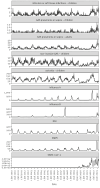Attribution of invasive group A streptococcal infections (iGAS) to predisposing viral infections, the Netherlands, 2010 to 2023
- PMID: 39364598
- PMCID: PMC11451131
- DOI: 10.2807/1560-7917.ES.2024.29.40.2300739
Attribution of invasive group A streptococcal infections (iGAS) to predisposing viral infections, the Netherlands, 2010 to 2023
Abstract
BackgroundAfter most COVID-19 pandemic control measures were lifted in 2022, many infectious diseases re-emerged. An increase in invasive group A streptococcal (iGAS) infections among adults and young children was reported by several countries. Viral infections including influenza and varicella, known risk factors for iGAS infection, also increased.AimTo estimate the proportion of GAS skin and soft tissue infections (SSTI) and pneumonia/sepsis in children (≤ 5 years) attributable to varicella, and the proportion of GAS pneumonia/sepsis in children and adults attributable to potentially predisposing respiratory viruses influenza A and B, RSV, hMPV and SARS-CoV-2 in the Netherlands.MethodsWe performed time series regression using weekly data on respiratory viruses, varicella and non-invasive GAS infections and GAS isolates cultured from blood, lower airways, skin, pus and wounds, from January 2010 to March 2023.ResultsIn 2010-19, 50% (95% CI: 36-64) of GAS SSTI in children were attributable to varicella. Between January 2022 and March 2023, 34% (95% CI: 24-43) of GAS SSTI cases were attributable to varicella. Of iGAS pneumonia/sepsis between January 2022 and March 2023, 34% (95% CI: 20-49) and 25% (95% CI: 18-32) was attributable to respiratory virus infections in children and adults, respectively, with the largest contributor (17%) being influenza A.ConclusionsPredisposing viral infections likely contributed to, but cannot fully explain, the observed iGAS increase among children and adults in 2022-23 in the Netherlands. Public health measures to control viral infections, such as vaccination against varicella or influenza, might reduce the iGAS disease burden.
Keywords: Influenza; Streptococcus pyogenes; Varicella; timeseries analysis.
Conflict of interest statement
Figures




References
-
- de Gier B, Marchal N, de Beer-Schuurman I, Te Wierik M, Hooiveld M, de Melker HE, et al. Increase in invasive group A streptococcal (Streptococcus pyogenes) infections (iGAS) in young children in the Netherlands, 2022. Euro Surveill. 2023;28(1):2200941. 10.2807/1560-7917.ES.2023.28.1.2200941 - DOI - PMC - PubMed
-
- European Centre for Disease Prevention and Control (ECDC). Increase in invasive group A streptococcal infections among children in Europe, including fatalities. Stockholm: ECDC; 2022. Available from: https://www.ecdc.europa.eu/en/news-events/increase-invasive-group-strept...
-
- Lassoued Y, Assad Z, Ouldali N, Caseris M, Mariani P, Birgy A, et al. Unexpected increase in invasive group A streptococcal infections in children after respiratory viruses outbreak in France: a 15-year time-series analysis. Open Forum Infect Dis. 2023;10(5):ofad188. 10.1093/ofid/ofad188 - DOI - PMC - PubMed
-
- Gouveia C, Bajanca-Lavado MP, Mamede R, Araújo Carvalho A, Rodrigues F, Melo-Cristino J, et al. Sustained increase of paediatric invasive Streptococcus pyogenes infections dominated by M1UK and diverse emm12 isolates, Portugal, September 2022 to May 2023. Euro Surveill. 2023;28(36):2300427. 10.2807/1560-7917.ES.2023.28.36.2300427 - DOI - PMC - PubMed
MeSH terms
LinkOut - more resources
Full Text Sources
Medical
Miscellaneous
